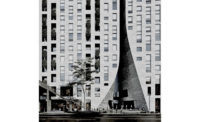Ben Waechter isn’t interested in designing something you’ve never seen before. Born in Eugene and based in Portland, the 47-year-old grandson of architect Heinrich Waechter would much rather refine something that already looks familiar to you—the “quintessential chair, room or garden, courtyard or alley”—in the hope of creating designs that are elemental and universal—architecture that’s enduring rather than “merely novel.”
While working for three years in the Genoa office of Renzo Piano Building Workshop, Waechter regularly took trips to Switzerland and steeped himself in Swiss modernism. From both experiences, he learned to balance simple form and spatial order with rich, materially driven construction techniques.
Waechter says his work is constantly evolving, at a slow, steady pace. “There’s something deeply satisfying about seeing the lessons learned in one project subtly inform the next,” he says.
Though reluctant to choose a favorite design, he will cop to having something of a “breakthrough revelation” while planning the Garden House, an 800-square-foot Accessory Dwelling Unit (ADU) in the backyard of a historic Portland bungalow. “There were just so many limitations on that project,” he says. “Code, budget, size, site. But we were ultimately able to coalesce these restrictions into a project that’s both striking and powerful.”
The takeaway? “No matter how complex a problem is, a singular solution can always be found.”
Waechter arrives at these solutions in a way that’s reductive rather than additive: he starts by gathering as many “facts” about a project as possible, then cultivates a central organizational idea. That’s when the real work begins: distilling, refining, whittling down.
“We take and take until we can’t take anything else without sacrificing function,” he says. “That’s our process, but also our philosophy. Sometimes the work is bold, and sometimes the moves are so subtle, the shift is almost imperceptible, hiding in plain sight.”
His passion for simplicity and subtraction—and his adherence to a minimal material palette—is a deliberate response to the glut of technologies, materials, and influences at architects’ fingertips nowadays. “Today we can achieve a kind of experimental complexity that was never possible before,” he says, “but the results can feel very fragmented. What we hope to achieve is something that allows people to feel more grounded in the world.”
Aside from building projects, Waechter has devoted his energies to documenting 10 of the firm’s designs in 30 different models, each one depicted in a concept model, a cast figure-ground model, and a white compositional model. It’s now only an internal project, but he eventually wants the series to be an exhibit: “We did this to better understand our own process through a documentation of the principles we aspire to, but also to see the body of work as a project in itself.”
Finding out exactly what those principles are, and learning how to articulate them, is an ongoing process; “one that will probably never be completed,” he says.
Waechter Architecture
FOUNDED: 2010
DESIGN STAFF: 6
PRINCIPALS: Ben Waechter
EDUCATION: University of Oregon, B.Arch., 1995
WORK HISTORY: Allied Works Architecture, 1997–99; Renzo Piano Building Workshop, 2000–03
KEY COMPLETED PROJECTS: Milwaukie Way, 2016; Red House, 2015; Garden House, 2015; Pavilion House, 2014; Tower House, 2013; Oakley House, 2013; Cape Cod House, 2010; Z-Haus, 2008 (all in Portland, Oregon)
KEY CURRENT PROJECTS: Furioso Vineyards, Dundee, OR; multifamily housing, Portland, OR










Post a comment to this article
Report Abusive Comment